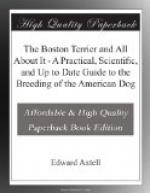devoid of fringe or coarse hair, and not
coarse hair, and not carried above the
carried above horizontal.
horizontal.
Tail faults: A long or gaily carried tail; extremely gnarled or curled against body.
(Note: The preferred tail should not exceed in length approximately half the distance from set-on to hock.)
4 Color: Brindle with
8 color: Any color,
white markings. brindle, evenly
marked
with white,
strongly
preferred.
10 Ideal markings:
White 4 markings: White
muzzle, even white blaze muzzle, blaze
on face,
over head, collar, collar, chest
and feet.
breast, part or whole of
forelegs and hindlegs
below hocks.
Color and markings faults: All white; absence of white markings; preponderance of white on body; without the proper proportion of brindle and white on head; or any variations detracting from the general appearance.
3 Coat: Short, smooth, 3 coat: Fine in texture, bright and fine in short, bright and not texture. too hard.
Coat faults:
Long or
coarse; lacking
lustre.
—– —– 100 100
Weights: Not exceeding weight: Lightweight class, 27 pounds, divided as 12 and not to exceed 17 follows: pounds; middleweight Lightweight: Under 17 class, 17 and not to pounds. exceed 22 pounds; Middleweight: 17 and not heavyweight class, 22 and exceeding 22 pounds. not to exceed 28 pounds. Heavyweight: 22 and not exceeding 27 pounds.
Disqualifications: Disqualifications: Docked Solid black, black and tail and any artificial tan, liver and mouse means used to deceive the colors. Docked tail and judge. any artificial means used to deceive the judge.
[Illustration: J. P. Barnard
The Father of the Boston Terrier]
[Illustration: Champion Sonnie Punch]
[Illustration: Rockydale Junior]
AN EARLY STANDARD
The following standard adopted when the dog was known
as the Round-Headed
Bull and Terrier Dog, will be of interest here.
Skull—Large, broad and flat.
Stop—Well defined.
Ears—Preferably
cut, if left on should be small and thin,
situated as near corners of
skull as possible; rose ears
preferable.




